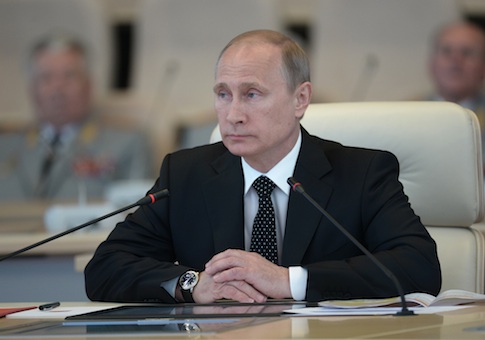Russia’s armed forces conducted a "massive" nuclear forces exercise on Thursday simulating NATO and U.S. nuclear attacks and involving several long-range ballistic and cruise missile firings.
The large-scale nuclear war drills come amid heightened tensions between Russia and the West over Moscow’s military annexation of Ukraine’s Crimea and Russian-instigated unrest in eastern Ukraine.
The exercises were monitored by Russian President Vladimir Putin and coincided with May 9 anniversary celebrations marking the victory in World War II.
"We are checking the preparedness of the Armed Forces of the Russian Federation, we are holding an exercise," Putin was quoted as saying, noting that the exercises were planned in November and involved all branches and services throughout the country, including nuclear forces.
Former Pentagon official Mark Schneider said the exercises are unusual and appear aimed the West.
"This type of exercise is normally held in the fall not the spring. Holding it now suggests to me that the intent was nuclear intimidation against NATO over the Ukraine," he said.
The latest nuclear saber-rattling by Moscow followed the April 14 test launch of a new ICBM, the SS-27 with multiple simulated warheads that potentially violated the 2010 New START arms treaty.
The war games also followed the Obama administration’s recent rejection of a Russian proposal aimed at resolving U.S. and Russian differences over missile defenses. Moscow wanted an agreement with legal restrictions on European-based defenses and the administration rejected the plan and cut off further talks because of the Crimea annexation.
For Thursday’s drills, an SS-25 road-mobile intercontinental missile, and two multiple-warhead SS-N-23 submarine-launched ballistic missiles were flight-tested.
State-controlled Russian news outlets described the drills as a "massive launch-on-warning missile strike and countering a nuclear attack by the means of the Moscow missile defense system."
A Russian Tu-95 strategic nuclear bomber conducted a salvo firing of six air-launched cruise missiles as part of the drills. And the Russians also carried out a test of missile defense interceptor against an incoming target. Short-range Iskander missiles and multiple-rocket launcher systems also took part.
The exercise involved what is called "launch-on-warning," the firing of missiles in response to radar indications of an incoming strategic missile attack.
Ground troops and air forces also took part in the exercises timed to a summit meeting of the Commonwealth of Independent States, former Soviet republics that are the target of Putin’s effort to reestablish a Soviet-like federation dominated by Moscow.
Presidents from Belarus, Armenia, Kyrgyzstan, and Tajikistan monitored the exercises from the Russian National Defense Command Center.
In rhetoric reminiscent of the Cold War, RIA Novosti news agency reported that aerospace defense forces "led by Russian President Vladimir Putin" successfully countered a massive nuclear missile strike.
"At the Priozersk training area (Kazakhstan), a successful interception of a ballistic target by a short-range countermissile was carried out. A massive rocket nuclear strike was repelled by a ballistic missile defense unit of air and missile defense troops," a Russian official told the news agency.
"The anti-missile system successfully struck the target that imitated a ballistic rocket."
The cruise missile firings in the Western military district simulated key military facilities of a foreign enemy.
Missile and artillery forces in the southern and central military districts also took part.
A Russian official said the main goal of the war games was "coordinating actions of various units in countering a large-scale missile- and air-attack."
The SS-25 was launched from the Plesetsk test site about 500 miles north of Moscow to the Kura test site in Kamchatka some 3,500 miles away.
The SS-N-23 was fired from a Delta IV missile submarine from the Barents Sea to Kamchatka.
A second submarine, also a Delta III, fired a second SSN-N-23 from the Sea of Okhotsk near the Pacific to the Chizha test site at the Kanin Peninsula, some 3,300 miles away.
It was Russia’s first submarine missile test launch from the Pacific in more than a decade, highlighting Russia’s shift in focus to the Pacific region.
Russian and Chinese naval forces are set to conduct joint military exercises in the region in the near future.
The missile defense interceptor was an ABM-3 Gazelle missile defense interceptor, that was fired from the Sarys Shagan test site. In its deployed state, the interceptor is armed with a 10-kiloton nuclear warhead.
"The command and control system of the Russian Armed Forces, the reliability of relaying of training orders and signals from the RF National Defense Command and Control Center to military districts and to command centers of military units and large units, to the strategic missile troops, the aerospace defense troops and the long-range aviation command were practiced in the course of the training," RIA Novosti reported.
"Strategic bombers, missile-carrying submarines of the Pacific and Northern fleets, mobile ground-based strategic missile systems and aerospace defense forces and resources were deployed in the training. Furthermore, large units of missile troops and artillery of the Southern and Central military districts were also deployed in the training," the new agency said.
